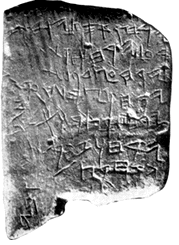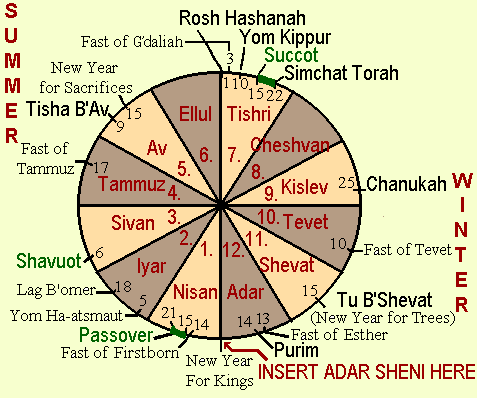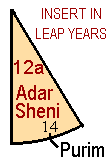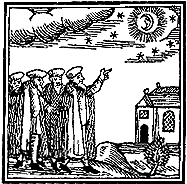
c. 10th Cent. BCE.
The Jewish calendar is based mainly on the phases of the moon; but it also regulates itself to a lesser degree by the sun. God said let there be lights in the firmament of the heaven to divide the day from the night; and let them be for signs and for festivals, for days and for years.1. There are twelve lunar months which begin at a new moon. Their names are Nisan, Iyar, Sivan, Tammuz, Av, Ellul, Tishri, Cheshvan, Kislev, Tevet, Shevat and Adar. Just as the Gregorian calendar has to add an extra day once in four years because the solar year is not an exact number of days, so the Jewish calendar adds an extra month, called Second Adar, seven time in nineteen years because it is not an exact number of months. This prevents the festivals moving round the year, as happens in some lunar calendars. This also enables harvest festivals to fall at set dates in the year.
(1.) Genesis 1, 14.

|
c. 10th Cent. BCE. |
Although the early history of the calendar is not clear, most scholars believe that the present calendar is a combination of two systems. One system began the year in spring and the other in autumn. In several places the Bible lists the festivals starting from the spring time.2. However, the autumn harvest festival is referred to as either at the end or the turn of the year.3. Another indication of the second calendar is found in the old names of months that are found there.4. At this period the years were reckoned according to year of the reign of the current Jewish king. One of the earliest Hebrew inscriptions which have been found is the c.10th century BCE Gezer Calendar, which lists an agricultural year beginning with the autumn harvest, written in ancient Hebrew script.
By the time of the Roman period Josephus was speaking of two new years one in spring and one in autumn.5. At the end of the 1st century CE the Jewish calendar had still not been fully accepted by all Jews. There was a famous dispute between Rabban Gamaliel II and Joshua ben Hananiah over the dates of festivals.6. While the Book of Jubilees and the sect of the Dead Sea Scroll community both observed a different calendar to other Jews.
(2.) Exodus 23, 14 - 19, Leviticus 23 and Deuteronomy 16. (3.) Exodus 23, 16 and Exodus 34, 22. (4.) Aviv in Exodus 23, 15, etc. Bul in 1 Kings 6 38, etc. Ziv in 1 Kings 6, 1 and Etanim in 1 Kings 8, 2. (5.) Antiquities 1, 3, #3. (6.) Rosh Hashanah 2, 8-9.
For many years the beginning of the months was fixed by observation of the new moon attested by witnesses coming before a Beth Din (Rabbinic Court).7. Leap year months were inserted when they went into the fields and found that the crops would not be ready for harvesting at Passover. However, in the 4th cent. CE, in the time of Hillel II astronomical knowledge was sufficiently advanced to enable dates to be fixed in advance by calculation and so the present calendar was fixed.
(7.) Rosh Hashanah 1, 3 and 2, 6ff.
Once the Beth Din had evidence that the new moon had been seen, (see FIXING THE CALENDAR) a new month was declared to have started, and people would know when to observe festivals. Some were informed by chains of beacons and signal fires; but this system was sabotaged by the Samaritans who lit fires on the wrong nights.8. Then messengers were sent to other towns and villages; 9. but by the time of the Roman period, Jews were living throughout the Roman Empire. Eventually it was decreed that Jews outside of Palestine should observe extra days of festivals in order to be sure of observing the correct date.
Even in Israel where only one day was observed, their system only worked for festivals which occurred in the middle of a month. As Rosh Hashanah fell on the 1st of Tishri they could not wait for an announcement before starting to celebrate New Year's Eve. So they kept two days of Rosh Hashanah.10. So today Jews in Israel observe two days Rosh Hashanah and only one day of other festivals. While Orthodox Jews outside Israel add extra days for festivals. Most Reform and Liberal Jews, who believe that there is no longer any doubt about the calendar dates, follow the Israeli practice.
(8.) Rosh Hashanah 2, 2-4. (9.) Rosh Hashanah 1, 3 and 2, 2. (10.) Freehof Modern Reform Responsa pp 286ff shows that the regular observance of two days in Israel only came in 11th Cent CE. Before then it was probably only done in special circumstances.
The Jewish dating is naturally different from the Gregorian year, as that is calculated from the estimated date of the birth of Jesus of Nazareth. The initials BC and AD are each based upon the belief that Jesus was part of a "Trinity" and also that he was the Messiah. Jews can not accept either of these propositions. When referring to a Gregorian date, Jews use CE and BCE, which stand for Common Era and Before the Common Era. The Jewish year is dated from a different base line. A calculation was made as to when the world was created, assuming that the chronology of births, ages and deaths of people mentioned in the genealogies in the Bible were historically accurate. This is described as AM standing for Anno Mundi, Year of the World. This abbreviation is only slightly less objectionable, as very many Jews now believe that the world is millions of years older than this. The correspondence of the two systems can be worked out from:-
| 2000 CE up till the Autumn = 5760 AM 2000 CE after Rosh Hashanah = 5761 AM |

LEAP YEARS occur in years 3, 6, 8, 11, 14, 17 and 19 of a nineteen year cycle. In leap years, a second month of Adar is inserted and Purim is celebrated in Adar Sheni in those years.
|

|
The festivals, which are based upon historical events do not form any recognisable pattern.
The reason why Passover and Succot are six months apart is probably because originally they were linked with the two equinoxes.
The Jewish calendar is used mostly for legal or religious purposes. Therefore, such things as Ketubot (wedding certificates) and tombstones usually have the Hebrew date. The date is also used in deciding when a child is eligible to have a Barmitzvah/Batmitzvah or for the observance of a Yahrzeit. For these purposes days are not calculated midnight to midnight, but from sunset to sunset. (see also SABBATH: STARTS AT SUNSET)
TO SEE TODAY'S JEWISH DATE CLICK HERE. |

|
New Moon, Amsterdam, 1695. |
New Moon or  (Rosh Chodesh) was a day of celebration. It was a half holiday for women. It was celebrated as a special day in Biblical times. When a woman told her husband that she was going to see the prophet Elishah, he said: Why will you go to him today? It is neither New Moon, nor Sabbath.11. This implied that like the Sabbath it was a holy day. While in the Talmud we find Whoever pronounces the benediction over the New Moon in its due time welcomes, as it were, the presence of the Shechinah, (the presence of God.)12.
(Rosh Chodesh) was a day of celebration. It was a half holiday for women. It was celebrated as a special day in Biblical times. When a woman told her husband that she was going to see the prophet Elishah, he said: Why will you go to him today? It is neither New Moon, nor Sabbath.11. This implied that like the Sabbath it was a holy day. While in the Talmud we find Whoever pronounces the benediction over the New Moon in its due time welcomes, as it were, the presence of the Shechinah, (the presence of God.)12.
On Rosh Chodesh like other festivals the psalms of the Hallel are said in the service and when it falls on Shabbat, an extra passage is read from the scroll. Orthodox Jews read Numbers 28, 9-15, while Reform congregations often read Genesis 1, 14-18. The Haftarah is Isaiah chap. 66. All these passages have references to the New Moon. If the Sabbath is the day before the New Moon one reads 1 Samuel 20, 18-42 which contains the phrase Tomorrow is the New Moon. On the Sabbath immediately before Rosh Chodesh it is the custom to insert a special prayer for the coming month.
(11.) 2 Kings 4, 23. (12.) Sanhedrin 42a.
| FOR FULL ALPHABETICAL INDEX |